Kindred Spirits
Trip dates: January 2, 2017 - January 3, 2017
During our time in Chiang Mai, one of the must-dos for me (ok, THE must-do) was to see and interact with elephants. Now before I get into the details of our elephant experience, let's rewind back a couple weeks to when I first started looking into it.
We had just arrived in Koh Chang and some other passengers in our minivan had told me about their experience with Elephant Nature Park and to book it as soon as possible, as they fill up fast. Since we didn't have many activities planned, I started researching that night. Elephant Nature Park is probably one of the most well-known "ethical" elephant sanctuaries in the Chiang Mai area and it was no joke when I was told that they booked up fast. Looking nearly a month out, almost all their experiences were already completely booked. There was only one spot left on one experience and that was it. Desperate to not miss out, I emailed ENP to ask if there was any way that we could book the experience for two, even though their reservation system only had space for one.
While waiting for them to reply on the off-chance that they check emails in the evenings, I started looking for other parks in the area as a back-up option. And down the rabbit hole I went. I ended up staying up into the early morning researching the myriads of options that were available and finding myself growing more skeptical with each site that I encountered. It seemed like every elephant camp, park or sanctuary was marketing themselves as "ethical" these days, which made it impossible to determine which ones actually are. And on that point, how does one even define what is ethical in this context?
The majority of elephant camps also say that they don't use hooks, "no hooks" being the other big buzzword you'll see on marketing pamphlets. From there, you can divide it down further into those that allow riding and those that don't. There are also those camps that conduct mahout training, some that include bareback rides and some that don't.
For most tourists that are trying to be consientious of what they are supporting with some passing research, myself included, "no riding" camps get the nod of approval as being legit at a passing glance. These camps all had similar itineraries, consisting of feeding the elephants and giving them a bath. Which got me to thinking, well how free and well-treated are these elephants, do they really want to have a bath every day, following the same path every day and doing the exact same thing day in and day out? I scoured TripAdvisor and the web for reviews on these camps and almost inevitably, I would come across accounts of tourists suspicious of whether hooks were being used when the guests couldn't see or other forms of obedience being practiced.
That's when I stumbled across Kindred Spirit Elephant Sanctuary. Their site said that they were a relatively new organization with a focus on returning elephants to the semi-wild where they can be free to roam as they please and just be elephants. Well, that sounds like the same message as ten of the other camps that I had just researched. But then I looked at their program itinerary and realized huh, there aren't any planned activities. You would hike to find the elephants and feed them and that was it. No planned baths, no set time on how long you have with the elephants. A little confused, I reached out to get more details about the itinerary and check on availability.
Fast forward to January 2017 and our 2D/1N program with Kindred Spirit Elephant Sanctuary. We were picked up in Chiang Mai for our 4 hour journey. Eric and I were in the back of the truck, so it was a little dusty and more than a little bumpy at times, but we had lots of space and great views of the gorgeous surroundings as we drove through a national park.
We arrived at our destination in the early afternoon, a Karen hill tribe village, where we were introduced to our homestay family. After dropping off our stuff, we got a tour of the village and the base camp for KSES.






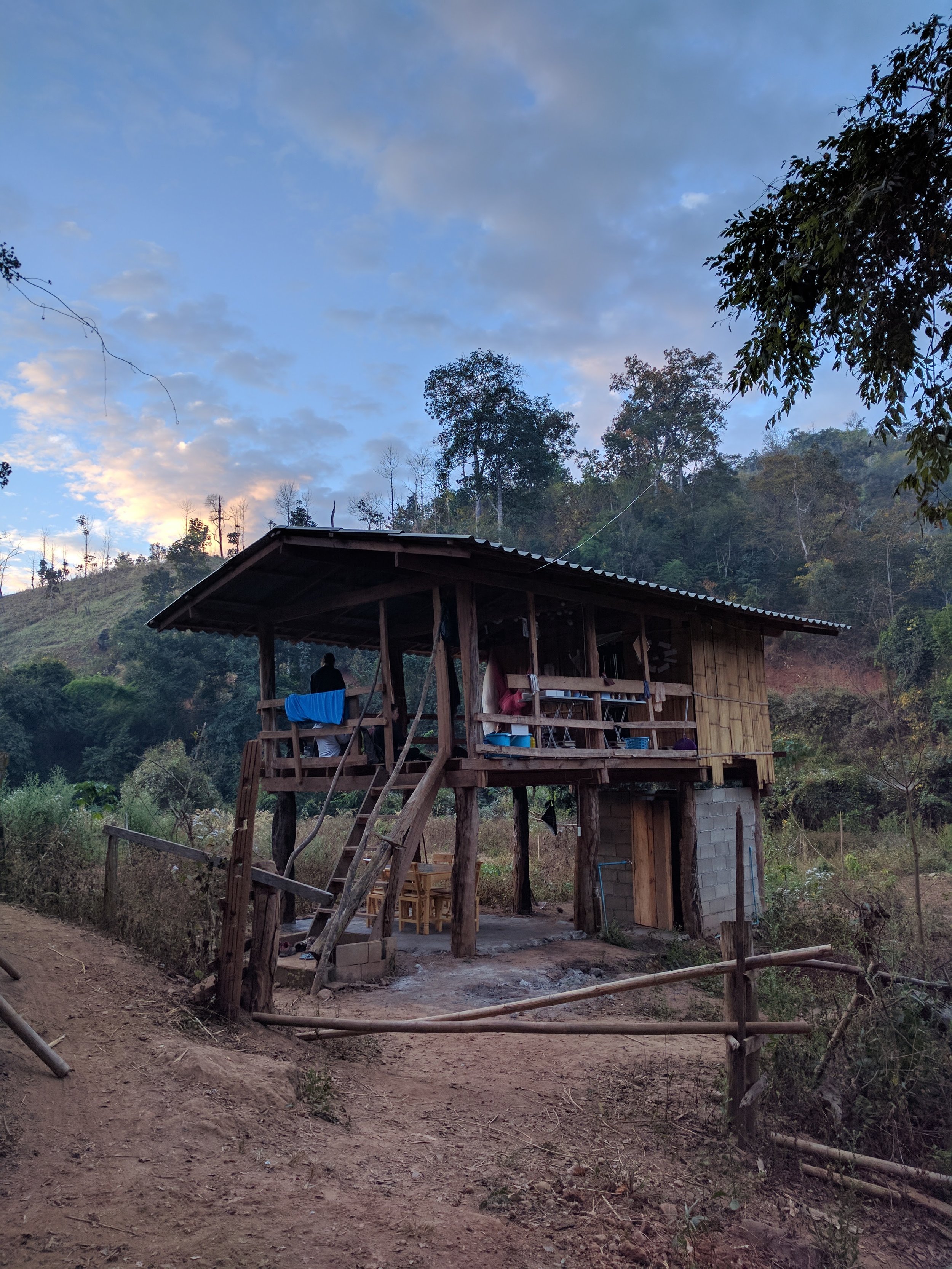


We then fed the local dogs (KSES buys kibble for them) before having dinner prepared by our homestay family. Other activities that evening included shopping (hand woven goods by the local women in the village) and basket weaving. We retired to bed soon after in preparation for the early morning ahead.










Around 4am, the roosters start going and soon, you hear all the animals of the village waking you up much earlier than you wanted. From the yipping of puppies, to the mooing cows, to the grunting pigs, and the chirping of baby chicks, it was quite a raucous morning wakeup call!
After breakfast at base, we were off to see the elephants! The mahouts (caretakers who have been with the elephants most of their lives) set out daily to keep an eye out on the elephants, making sure that they don't wander into a farm and accidentally cause a human-elephant conflict. So when we set off on our hike, we already had a decent idea of where the elephants are and don't have to spend too long looking for them. Our hike took about an hour, going along the river and passing by corn fields - the scenery was beautiful!








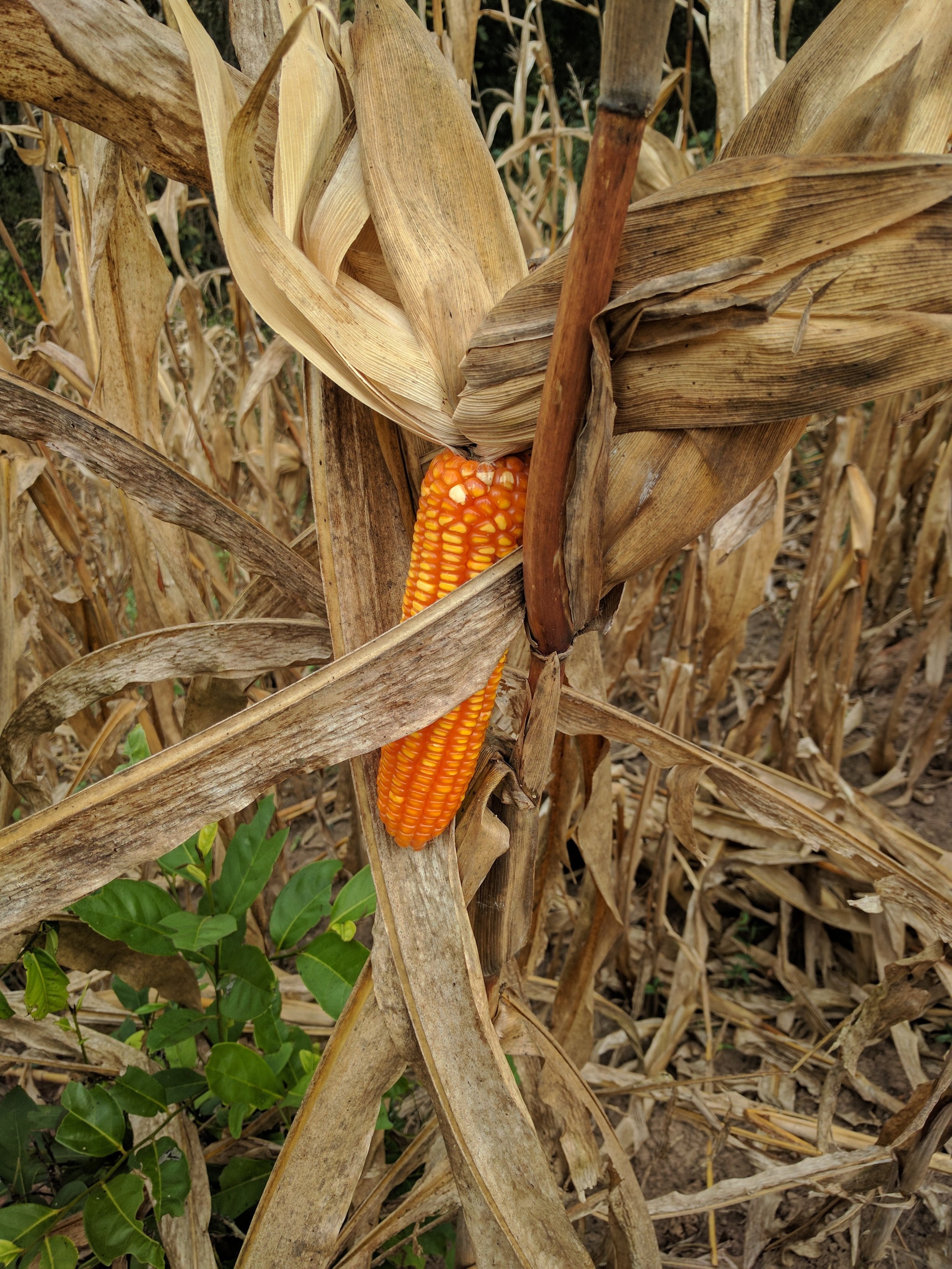

As we crested the final hill, I saw the elephants at the top going through corn husks looking for unharvested corn. We shook our bags of bananas that we brought and soon, the gentle giants started lumbering down towards us.
KSES has rescued four elephants so far: Too Meh, the matriarch of the group; Mae Doom, her daughter; Gen Thong, the baby of the group (Mae Doom's nephew and Too Meh's grandson); and Boon Rott, an adolescent male and the most people-friendly of the bunch.
We fed our bananas to the four elephants (they have a voracious appetite!) and then just settled down to watch them as they wandered around, being careful to stay out of their paths. The elephants, as big as they are, can be surprisingly quiet and sneak up on you!














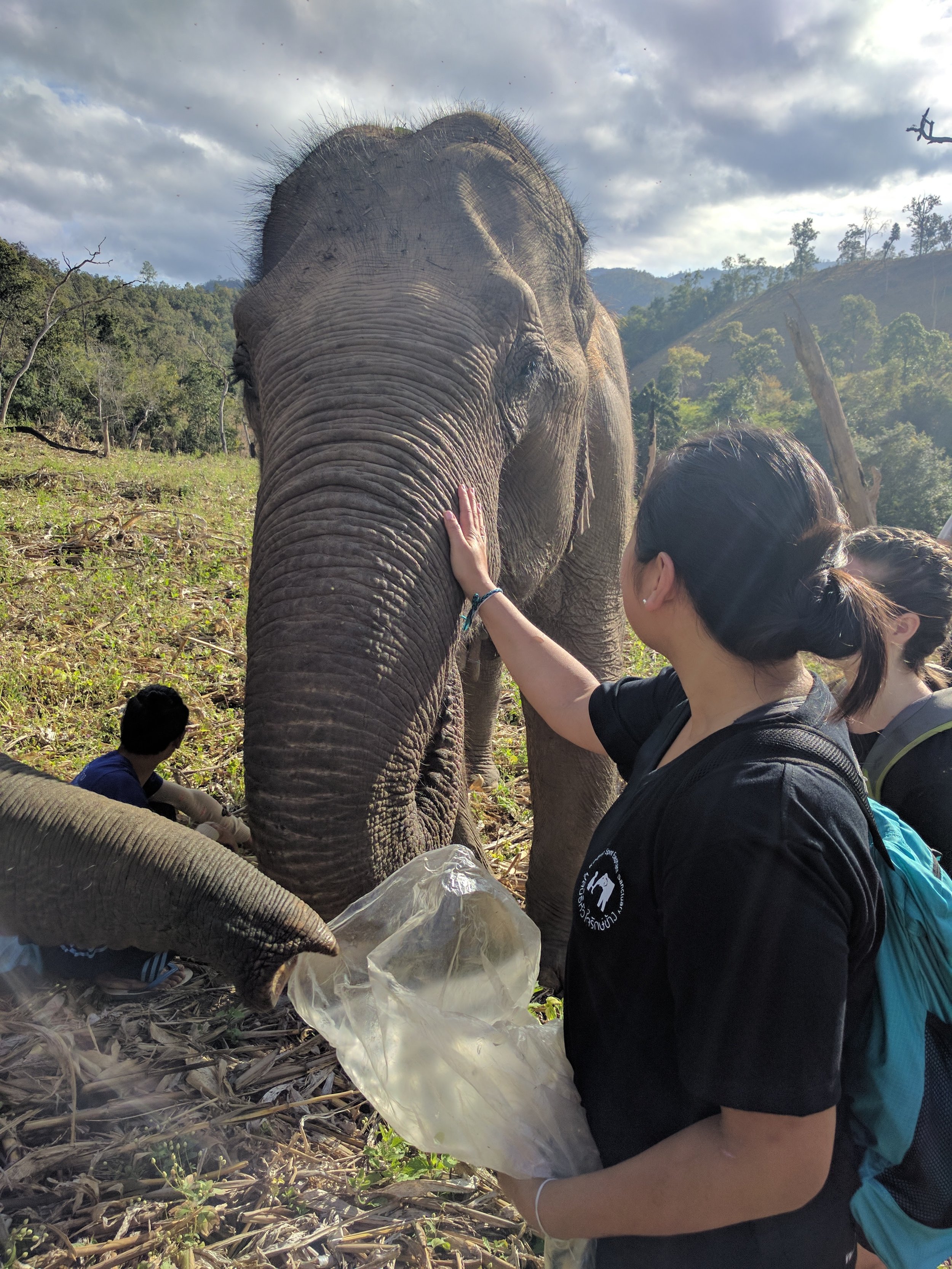




There was no agenda that the elephants had to follow; when they were satisfied that they had found all our bananas, they wandered a ways away to forage and flirt. After a while though, they noticed we were still there and decided to come back and inspect us for more food.














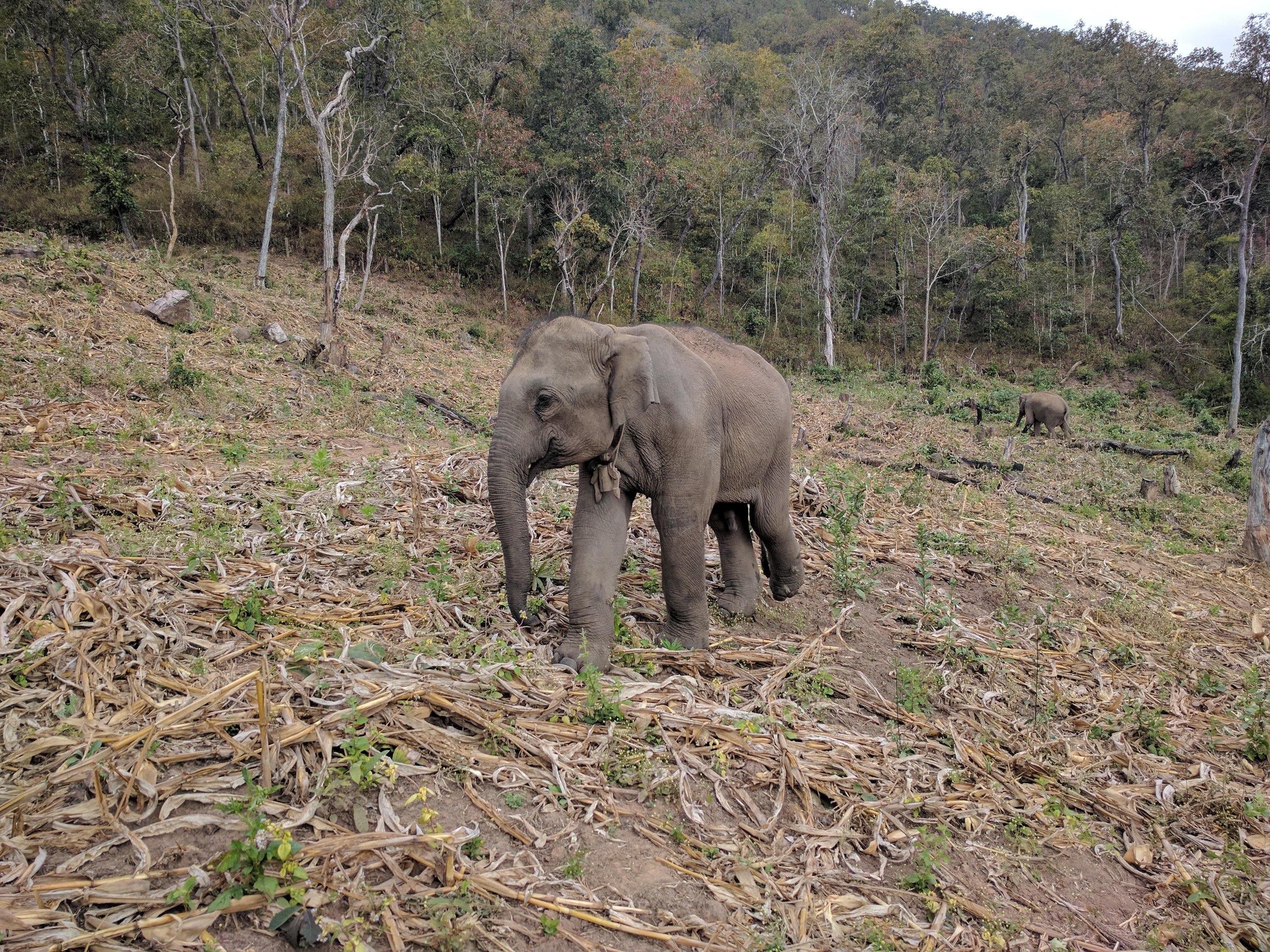



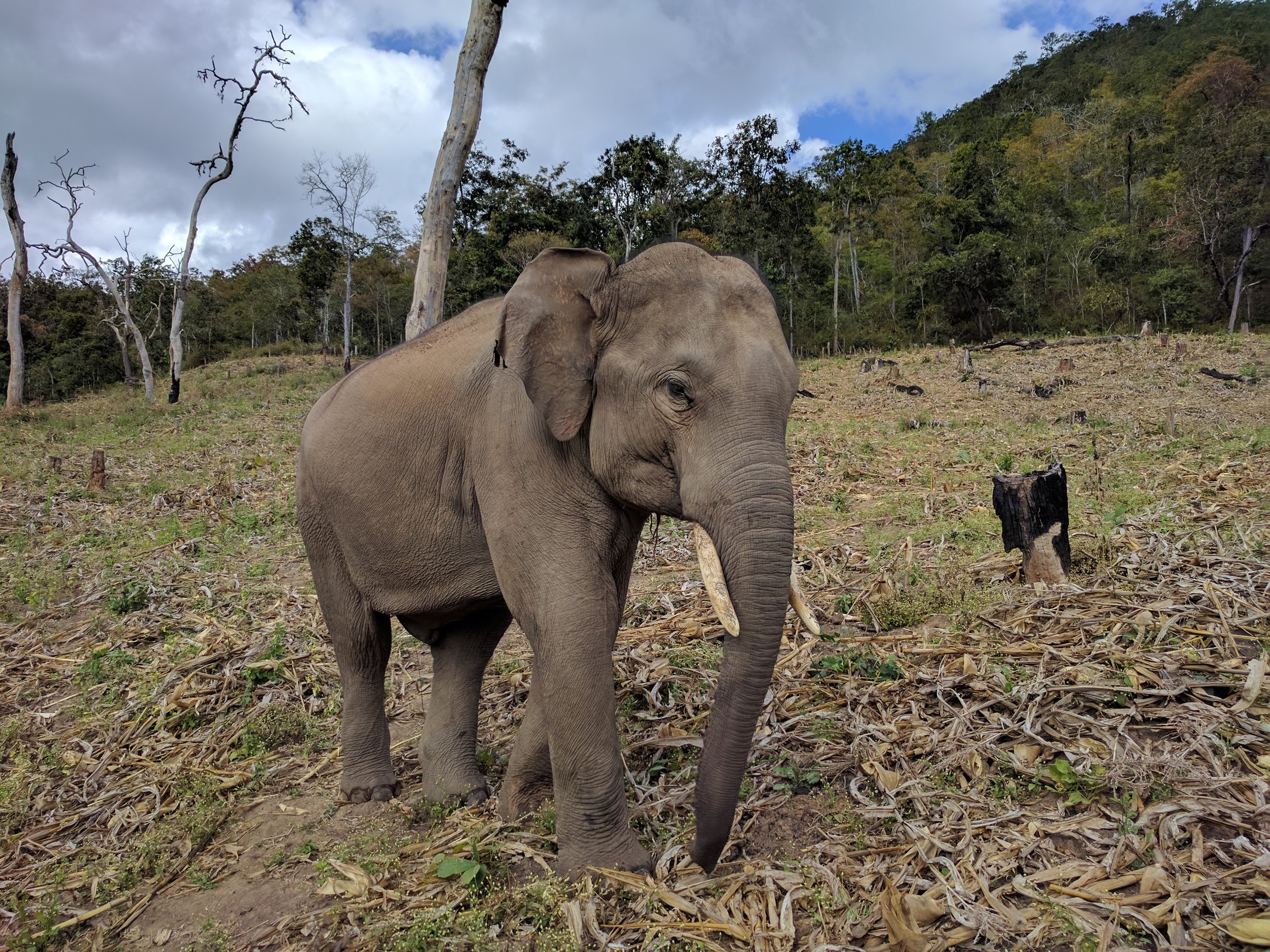





Eventually, the elephants wandered on into the jungle and it was time for our lunch. Each of the homestays packed lunches for the volunteers. The mahouts also chopped up some bamboo to steam eggs and cook some elephant dung beetles, and we had a potluck lunch in the forest.







As we were packing up, we noticed that Boon Rott was hiding down the stream and keeping an eye on us. As we crossed to leave, he came to see us off one last time!






It was truly amazing and a wonder to see these elephants up close and on their own terms. Aside from the wild on a safari, I can't imagine another opportunity to interact with them in such an open environment. KSES is truly special and lucky that they have the jungle area nearby for their elephants to roam, and I hope that they can rescue more elephants to bring home.
KSES rents their elephants on a monthly basis from the Karen hill tribe. This provides the owners with a monthly income so that they don't need to rent their elephants to another camp or for other tourism purposes. KSES rents the elephants instead of buying them because this helps guarantee the owner with continued income to feed their family. If you pay a lump sum for the elephant, then the lump sum will get used to purchase another elephant (usually illegally from poaching in Myanmar) and the cycle continues. KSES is also promoting eco-tourism by trying to provide the local Karen tribe with additional sources of income, via the homestay program as well as the miscellaneous other activities such as cooking classes, massages, and the sale of woven goods to visitors.
There is a ton of misinformation out there regarding elephants and elephant tourism. As a tourist, it's really difficult to discern what is true and what camps are worth supporting. I know that KSES' program may not be for everyone; it requires a time commitment of 2 days minimum and a homestay with only squatty potty facilities and cold bucket showers might be a deal breaker (I'm generally not a fan but for me, it's worth it for the elephants). However, if you're looking to do an elephant encounter, whether it's in Chiang Mai or any of the other neighboring areas (Laos, Myanmar, etc) please do your research and consider the following when deciding which camp to visit.
Elephant tourism is a necessary evil. Due to deforestation and population growth, there's not enough land for Asian elephants to be released back into the wild. Elephant tourism isn't all bad, they just need to be operated in an eco-friendly manner.
When a camp advertises itself as ethical with no hooking and no chains, ask how is this possible? Elephants require a lot of land to roam and it's unrealistic that they're never chained. At KSES, the elephants are chained at night since the mahouts need sleep. They are kept on 12m chains so they still have enough length to socialize with one another and forage a bit. So instead of looking for camps that claim to not use chains, ask about when and how they are kept from going somewhere they shouldn't.
As I have yet to find another camp that's like KSES, if you're interested in one that has a more set itinerary, ask about the structure of the elephant's day. How long do they have to roam and forage and socialize? What are the elephants doing/where are they kept when there aren't visitors?
Also, don't assume that all riding camps are bad. The ones that make use of the seat are no bueno, elephants backs aren't meant to carry weight. The mahout-training ones where you ride on their necks may be OK. Obviously riding isn't the best thing for the elephants, but with the right regulations, it might be OK. Are the elephants restricted to only 1 or 2 rides per day? What's the max number of people allowed on the elephant? How much time are they allowed to roam and forage vs the amount of time they are working each day?
Obviously this isn't inclusive of everything you need to know, and you should trust your instincts and make your own judgment. If you want an additional perspective, check out a fellow KSES volunteer's blog on the topic here.
I know that it can be hard as a tourist to say no to being able to interact with the elephants as much as possible in a guaranteed setting. But trust me when I say that being able to see them in their natural environment is 100x more rewarding and magical than any amount of riding/bathing/hugging that you'll get with an enclosed elephant. Please please please be cognizant of what you're supporting when you sign up for animal encounters, and consider visiting KSES if you are in Chiang Mai and have the time.
#savetheelephants














